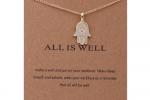Judaica: Hamsa Necklace, All Is Well
Pendant Necklace on Brown "All Is Well" Card
14k gold plated on tin alloy
Length: 45cm+5cm Link Chain
Made in the USA.
THIS YEAR, 10% OF ALL proceeds from the sale of Judaica here will be donated to Independent Jewish Voices Canada . I, Tracey TieF, as Anarres Natural Health and Tikkun Olam Judaica do not necessarily know of, or support the views of the makers, vendors or manufacturers of the goods I sell. Neither do my views reflect on the makers, vendors or manufacturers of the goods I sell, although I hope that all support a Just Peace.
~~~~~~~~~~~~~~~~~~~~~~~~~~~~~~~~~~~~~~~~~~~~~~~~~~~~~~~~~~~
I encourage you to help support Palestinian farmers in many ways. I am selling stickers, buttons, and lotions to support the replanting of olive trees:
Self-Loving Jew Button and Sticker
or support Zatoun farmers through a Trees for Life Sponsorship
~~~~~~~~~~~~~~~~~~~~~~~~~~~~~~~~~~~~~~~~~~~~~~~~~~~~~~~~~~~
ABOUT THE HAMSA SYMBOL
The Hamsa (Arabic: خمسة khamsah; Hebrew: חַמְסָה, also romanized khamsa; Berber languages: ⵜⴰⴼⵓⵙⵜ tafust) is a palm-shaped amulet popular throughout the Middle East and North Africa and commonly used in jewelry and wall hangings. Depicting the open right hand with five digits, the hamsa has been used as a sign of protection throughout history, predominantly by Muslims and Jews. Its origins may lie in Ancient Egypt or Carthage (modern-day Tunisia) and may have been associated with the Goddess Tanit.
The Hamsa is also known as the Hand of Fatima after the daughter of the prophet Muhammad, the Hand of Mary, the Hand of Miriam, and the Hand of the Goddess.
As a symbol, the hamsa can carry several meanings:
* That God exists in everything
* That one is protected from evil and danger
* Representing femininity and women's sacredness
* Representing God's hand reaching down from heaven
* Representing priesthood, that one is of priestly descent
* God's willingness to help people and direct us out of struggle
The hamsa can be seen as a symbol of unity among North African and Middle Eastern peoples, worn as a prayer that All is Well.



